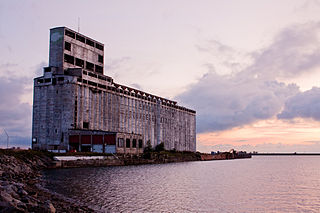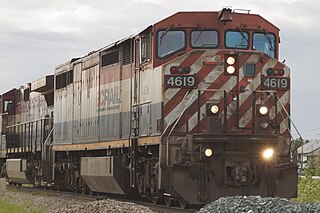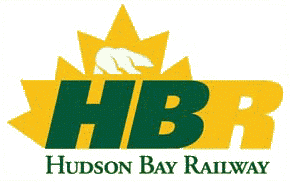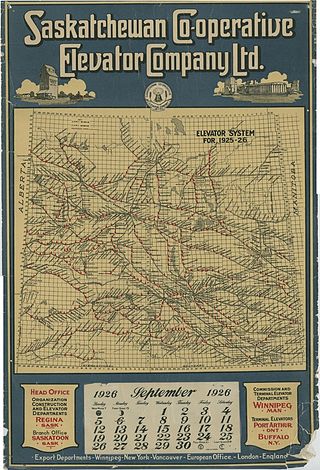
A grain elevator is a facility designed to stockpile or store grain. In the grain trade, the term "grain elevator" also describes a tower containing a bucket elevator or a pneumatic conveyor, which scoops up grain from a lower level and deposits it in a silo or other storage facility.

BC Rail is a railway in the Canadian province of British Columbia.

The United Farmers of Alberta (UFA) is an association of Alberta farmers that has served different roles in its 100-year history – as a lobby group, a successful political party, and as a farm-supply retail chain. As a political party, it formed the government of Alberta from 1921 to 1935.

The Canadian Wheat Board was a marketing board for wheat and barley in Western Canada. Established by the Parliament of Canada on 5 July 1935, its operation was governed by the Canadian Wheat Board Act as a mandatory producer marketing system for wheat and barley in Alberta, Saskatchewan, Manitoba, and a small part of British Columbia. It was illegal for any farmer in areas under the CWB's jurisdiction to sell their wheat and barley through any other channel than the CWB. Although often called a monopoly, it was actually a monopsony since it was the only buyer of wheat and barley. It was a marketing agency acting on behalf of Western Canadian farmers, passing all profits from its operation back to farmers. Its market power over wheat and barley marketing was referred to as the "Single Desk".

Forestburg is a village located in east-central Alberta, Canada. The rich farmland of the area was first settled in 1905. Soon after the first of many "gopher hole" mines, homesteaders were soon coal mining on the banks of the Battle River in 1907.

Hudson Bay Railway is a Canadian short line railway operating over 1,300 kilometres (810 mi) of track in northeastern Saskatchewan and northern Manitoba.
Alliance is a village in central Alberta, Canada. Established as a station on a Canadian Northern Railway (CNoR) line in 1916, Alliance became a village in 1918. It is located on Highway 602, approximately 160 km (99 mi) east of Red Deer. The village is 2 km (1.2 mi) east of Veterans Memorial Highway and 2.5 km (1.6 mi) north of the Battle River.

The Port of Churchill is a privately-owned port on Hudson Bay in Churchill, Manitoba, Canada. Routes from the port connect to the North Atlantic through the Hudson Strait. As of 2008, the port had four deep-sea berths capable of handling Panamax-size vessels for the loading and unloading of grain, bulk commodities, general cargo, and tanker vessels. The port is connected to the Hudson Bay Railway, which shares the same parent company, and cargo connections are made with the Canadian National Railway system at HBR's southern terminus in The Pas. It is the only port of its size and scope in Canada that does not connect directly to the country's road system; all goods shipped overland to and from the port must travel by rail.

The Saskatchewan Wheat Pool was a grain handling, agri-food processing and marketing company based in Regina, Saskatchewan. The Pool created a network of marketing alliances in North America and internationally which made it the largest agricultural grain handling operation in the province of Saskatchewan. Before becoming Viterra, SWP had operated 276 retail outlets and more than 100 grain handling and marketing centres. The Saskatchewan Wheat Pool operated under the name of AgPro in the prairie provinces of Manitoba and Alberta. Begun as a co-operative in the 1920s, the company became a publicly traded corporation in the 1990s. After the 2007 takeover of its competitor, Winnipeg-based Agricore United, the Pool name was retired. The merged company operated under the name Viterra until 2013, when it was acquired by Glencore International.

The United Grain Growers, or UGG, was a Canadian grain farmers' cooperative for grain storage and distribution that operated between 1917 and 2001.

The CBH Group, is a grain growers' cooperative that handles, markets and processes grain from the wheatbelt of Western Australia.

A wheat pool is a co-operative that markets grain on behalf of its farmer-members.
The Warner elevator row is a group of four historic wood-cribbed grain elevators standing in a row from south to north alongside the Canadian Pacific Railway line from Great Falls, Montana to Lethbridge, Alberta at the east entrance of the village of Warner, Alberta, Canada. At one time, the row had at least seven elevators.

The Alberta Central Railway Museum is a railway museum located south-east of the City of Wetaskiwin, in Central Alberta, Canada. The main building was designed as a scaled-down version of the City's 1907 Canadian Pacific Railway depot. The depot includes a waiting room, baggage room and telegraph office, as well as exhibits and railroad artifacts. Railroad equipment includes locomotives, a sleeper car, passenger coach, freight equipment, cabooses, freight cars and a snowplough. Attractions include a model train layout of the original Wetaskiwin railyard. The museum also features a 1906 Alberta Grain Co. grain elevator which was moved from Hobbema. The elevator is known to be Alberta's second-oldest grain elevator in the Province. Rides are given on a one-mile loop of track.
Battle River Generating Station is a natural gas-fired power station owned by Heartland Generation, located near Forestburg, Alberta, Canada. Formerly a coal-fired power station, the generating station transitioned off coal in 2021. Coal is provided by the Forestburg Collieries operated by West Moreland Coal, while natural gas is supplied by the Pembina Keephills Transmission pipeline.
The Southern Rails Cooperative Ltd. (SRCL) is a Canadian short line railway company operating on trackage in southwest Saskatchewan. Southern Rails Cooperative was the first shortline railway to operate in Saskatchewan and operated as the first modern common carrier shortline railway. The railway is a farmer owned co-operative that operates two short-line railways in Saskatchewan, totalling 71 km of trackage: the former Canadian Pacific Railway Colony subdivision that runs from Rockglen to Killdeer, and the former Canadian National Railway Avonlea subdivision that runs from Avonlea to Parry, The company subsequently expanded along the Avonlea subdivision into Moose Jaw.

The Battle River Railway Trestle, commonly known as the Fabyan Trestle Bridge, was constructed between 1907 and December 10, 1908 west of Fabyan, Alberta, Canada at the cost of $600,000. The bridge is located at approximately mile 149 of Canadian National Railway's (CN) Wainwright subdivision.

The Saskatchewan Grain Growers' Association (SGGA) was a farmer's association that was active in Saskatchewan, Canada in the early 20th century. It was a successor to the Territorial Grain Growers' Association, and was formed in 1906 after Saskatchewan became a province. It provided a voice for farmers in their struggle with grain dealers and the railways, and was influential in obtaining favorable legislation. The association initially resisted calls to create a farmer-owned marketing company. Later it did support formation of the Saskatchewan Co-operative Elevator Company. The SGGA helped the Saskatchewan Wheat Pool, a cooperative marketing organization, to become established in 1924. In 1926 the SGGA merged with the more radical Farmers' Union of Canada, which had earlier split from the SGGA, to create the United Farmers of Canada,

The Saskatchewan Co-operative Elevator Company (SCEC) was a farmer-owned enterprise that provided grain storage and handling services to farmers in Saskatchewan, Canada between 1911 and 1926, when its assets were purchased by the Saskatchewan Wheat Pool.

The Alberta Farmers' Co-operative Elevator Company (AFCEC) was a farmer-owned enterprise that provided grain storage and handling services to farmers in Alberta, Canada between 1913 and 1917, when it was merged with the Manitoba-based Grain Growers' Grain Company (GGGC) to form the United Grain Growers (UGG).















